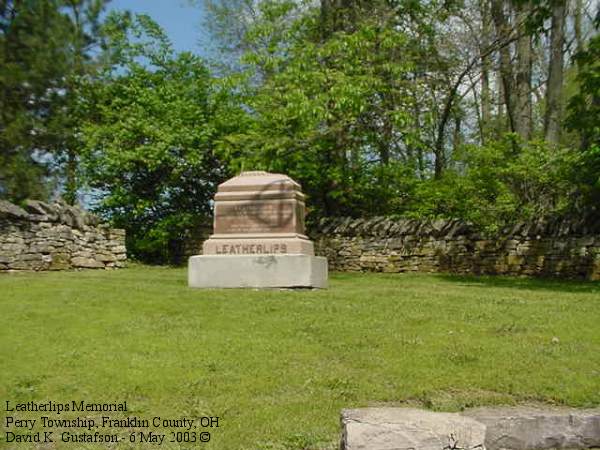Leatherlips Cemetery
Dublin, Perry Township,
Franklin County, Ohio
Gravestone Photographs
Though only a single grave is located here, this well kept triangle at the corner of Stratford Avenue and Riverside Drive (State Route 257) near the Delaware County line contains a huge rose granite stone placed in the center commemorating the execution of Leatherlips, a chief of the Wyandots.
Aerial Photo
Spring 2004
Leatherlips Memorial (close-up), Leatherlips, a chief of the Wyandot tribe of Indians, was executed on this spot June 1, 1810. Erected by the Wyandot Club of Columbus Ohio 1889
The story of this execution can be found in Henry Howe's Historical Collection of Ohio; An Encyclopedia of the State (Cincinnati 1904), page 609.
In June, 1810, there was an old Wyandot Chief, named Leatherlips, executed in this county, and it is claimed for the sole reason that he was a friend of the white man and opposed to taking up armies against the whites. We take the account of this event from "Drakes Life of Tecumseh" where it is abridged from an article by Otway Curry, in the "Hesperian"
Gen. Harrison entertained the opinion that his death was the result of the prophet's command, and that the party who acted as executioners went directly from Tippecanoe to the banks of the Scioto, where the tragedy was enacted. Leatherlips was found encamped upon that stream, twelve miles above Columbus. The six Wyandots who put him to death were headed, it is supposed by the Chief Roundhead. An effort was made by some white men, who were present, to save the life of the accused, but without success. A council of two or three hours took place; the accusing party spoke with warmth and bitterness of feeling: Leatherlips was calm and dispassionate in his replies. The sentence of death, which had been previously been passed upon him was reaffirmed.
"The prisoner then walked slowly to his camp, partook of a dinner of jerked venison, washed and arrayed himself in his best apparel and afterwards painted his face. His dress was very rich -- his hair gray and his whole appearance graceful and commanding." When the hour for the execution had arrived, Leatherlips shook hands in silence with the spectators. "He then turned from his wigwam, and with a voice of surpassing strength and melody commenced the chant of the death song. He was followed closely by the Wyandot warriors, all timing with
their slow and measured march the music of his wild and melancholy dirge. The white men were likewise all silent followers in that strange procession. At the distance of seventy or eighty yards from the camp, they came to a shallow grave, which, unknown to the white men, had been previously prepared by the Indians. Here the old man knelt down, and in an elevated but solemn tone of voice, addressed his prayer to the Great Spirit. As soon as he had finished,
the captain of the Indians knelt beside him and prayed in a similar manner. Their prayers, of course, were spoken in the Wyandot tongue... After a few moments delay, the prisoner again sank down upon his knees and prayed, as he had done before. When he had ceased, he still
continued in a kneeling position. All the rifles belonging to the party had been left at the wigwam. There was not a weapon of any kind to be seen at the place of execution, and the spectators were consequently unable to form any conjecture as to the mode of procedure which the executioners had determined on for the fulfillment of their purpose. Suddenly one of the warriors drew from beneath the skirts of his capote, a keen, bright tomahawk--walked rapidly up behind the chieftain--brandished the weapon on high for a single moment, and then struck with his whole strength. The blow descended directly upon the crown of the head, and the victim immediately fell prostrate. After he had lain awhile in the agonies of death, the Indian captain directed the attention of the white men to the drops of sweat which were gathering upon his face and neck; remarked with much apparent exultation, that it was conclusive proof of the sufferers guilt. Again the executioner advanced, and with the same weapon inflicted two or three additional and heavy blows. As soon as life was entirely extinct, the body was hastily buried, with all it's apparel and decorations, and the
assemblage dispersed."
 |






